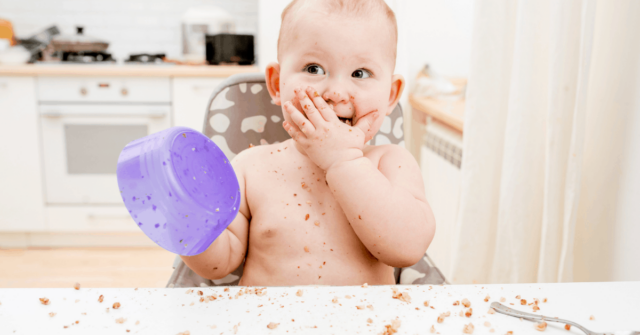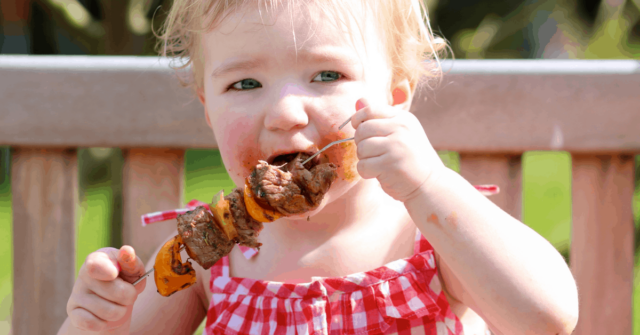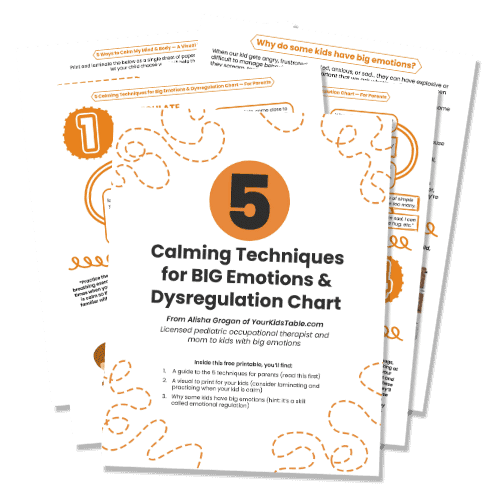How many times a day do toddlers need to eat? How do you teach a baby to chew? And, how do you wean? Find out the answers to these pressing feeding questions from parents about their babies and toddlers inside…
This is the second installment of our Ask Me Anything series. Our Your Kid’s Table newsletter community submitted hundreds of smart and wise questions to get answered by an occupational therapist and feeding/sensory expert, that’s me! In the first Ask Me Anything post, we covered 5 different questions from parents with sensory kids, and for this post, it’s all about feeding babies and toddlers.
If you have a kiddo 24 months old or less, then you don’t want to miss this very valuable Q and A because so many parents wish they’d known how to handle some of these tricky feeding situations sooner.
Affiliate links used below. See our full disclosure.
5 Feeding Baby/Toddler Questions Answered by An OT
Question #1:
How do I know my toddler is getting all the nutrients they need, how do I encourage him to want to feed himself? – Sarah
Toddlers are typically not the best eaters. They often slam a handful of food in their mouth, throw most of the rest on the floor, and then want to hop down ending the meal.
It’s frustrating, but it’s normal.
You may wonder how they’re getting enough calories, fat, and vitamins to grow? Rest assured, most toddlers are able to self regulate their needs, and they need far less to eat then we think. The most a toddler can eat is the size of their fist. We tend to give much bigger portion sizes because we feel good when they eat a lot. (Check out the best portion sizes for toddlers.)
On top of that, toddlers tend to binge eat. It’s common for a toddler to eat really well at one meal and then not eat hardly anything for the next 5 meals.
Another reason toddlers seem to eat less, is because they actually do. At around 12 months, their growth slows down significantly and they need fewer calories then they did at 9 months old!
To learn more about all of the specific vitamins and caloric needs for toddlers, check out pediatric dietitian Sarah Remmer’s incredible advice in: Does Your Child Need Vitamins?
How Do I Teach My Child to Feed Them-self…
I look for toddlers to be feeding themselves independently with a fork or spoon by 24 months old. For the average toddler, we see this skill emerge usually around 15 months.
Spoon feeding is easier, and is a good place to start.
If your toddler keeps turning the spoon over and losing all the food, you might want to try a bent handled spoon like this one.
Focus on starting slow, and putting your hand on top of your child to show them how to feed them-self. Then move towards alternating bites. You feed them a bite, they try a bite on their own.
I’ve got a full tutorial here: Self-Feeding: The Complete Guide for Babies and Toddlers
Question #2:
How to make my toddler love chicken or meat? – Raquel
A lot of toddlers will pass on meat because the texture feels strange and they have to chew a lot to eat it. But, toddlers can learn to eat meat. If your child likes bread and other snack foods, often your best in road to meat is by breading it. (I explain how to do that in this trick for picky eaters.
I like to start with breaded chicken, aka chicken nuggets. But, not any chicken nugget will do. It’s important that they’re small and thin. Yummy brand dino nuggets, of which I have no affiliation, I’ve found to be perfect. Other brands of dino nuggets are often too thick.
Over cooking and getting chicken nuggets crispy is often a texture that’s more readily received and eaten as well.
If you can’t find thin, small nuggets in the store, don’t worry, I have an amazing chicken nugget recipe! It’s extremely successful and easy.
Head over to How to Get Your Kid to Eat Meat to learn more tips and strategies
Question #3:
How many times per day should my 12 month old be eating? Our ped recommended 3 meals and 2 snacks, but my son doesn’t seem to have that big of an appetite and I feel like we are constantly at the table. -Elaine
3 meals and 2 snacks is definitely appropriate, but so is one snack. Make snacks a much smaller meal so it’s brief, especially if they don’t seem hungry for it.
12 -14 months is a tough feeding time because you’re probably weaning from the breast or the bottle, and there’s a lot of shifting schedules depending on when they nurse/have a bottle.
The schedule is sort of a fluid experience during this time, while you work your way towards 3 solid meals and 1-2 snacks.
Check out: Feeding Schedule for 11, 12, and 13 month olds to see how I schedule meals during this phase.
Question 4:
Help with weaning and how to get my 12 month old to eat more solids and be less dependent on breastmilk as a main source of calories/nutrition, how to get her to drink milk from a cup and not just the bottle (even though she will drink water from a cup)? – Rachel
We’ve got a couple of questions to unpack here.
Let’s start with weaning. The best way to start this process is by beginning to pair nursing or bottles with mealtimes. You can start with just one meal. So, when your child has lunch, you feed them a bottle right after, instead of sometime beforehand. At the same time, you’re going to serve milk in a cup with their meal.
Over time, they will start to drink more milk from the cup! It’s a process for some kids and can take some time. Once they start drinking from a cup, then you start to eliminate those nursings/bottles. Usually, the bedtime and before nap bottles are last to go.
That was a quick nutshell answer, but I’ve got two detailed posts for you to learn more about weaning:
The next question is about drinking milk from a cup. A lot of toddlers will refuse to take milk from a cup because they associate the taste with a bottle or nursing. It’s a tough transition, but being consistent and patient will pay off.
What I’d recommend is having a special cup that looks different from their water cup for milk. Put it out at every single meal. Take and toss cups can work great for this because they can see it’s milk and also suck up the milk easily.
If you’re comfortable, you could also add chocolate or strawberry syrup to it so it looks a little different and will be more palatable. If they go for the mixed in syrups, then you can slowly put less and less in each day until they’re just drinking milk. You can also make a milkshake or smoothie and in the same way, decrease the other ingredients until they’re only drinking milk.
Usually through repeatedly offering, being positive, and showing her how you take sips of milk will help her start to drink milk from a cup.
You can learn more in: How Much Milk Does A Toddler Need
Question 5:
How do you teach your child to use her gums to chew when she only has two teeth, but you know she wants to EAT her food and not eat pureed food? – Toni
Fun fact: babies and toddlers don’t need teeth to eat! We assume they do, but their gums are actually strong enough. If you notice that your baby or toddler isn’t chewing food, then it’s likely related to their muscle strength and coordination. This is called their oral motor skills.
But, it’s easy to assume kids aren’t chewing, sometimes they aren’t eating because of the texture of food. If you see your child is resistant to touch, look at, or taste foods, their sensory processing is likely a component.
And, it could be a combination of both. Either way, they both can be improved. And, you can directly teach your child to chew.
Get step by step instruction right here: How to Teach Your Baby or Toddler to Chew So They Can Eat Safely
If your child is struggling to eat table foods at all though, make sure you grab a seat in our free workshop too: 5 Mistakes That Are Stopping Your Child From Learning to Eat Table Foods
Have a question about feeding your baby or toddler that I didn’t cover? Drop it in the comments below, we’d love to help!
More on Feeding Babies and Toddlers
Feeding Red Flags for Babies and Toddlers
5 Weight Gain Tips for Picky Kids Toddlers
Feeding Schedule for 8, 9, and 10 month olds
The Ultimate Guide to Feeding Milestones for Babies and Toddlers
Alisha Grogan is a licensed occupational therapist and founder of Your Kid’s Table. She has over 15 years experience with expertise in sensory processing and feeding development in babies, toddlers, and children. Alisha also has 3 boys of her own at home. Learn more about her here.






So our twins throw their food on the floor when they don’t want it and also when they are done eating, I’ve tried many ways to combat this by even having them give me the food when they are done or do t want it. Doesn’t seem to work. Any suggestions.
Hey!
Thanks for reaching out, we understand how hard this can be! We do have an article you can read with some suggestions for you. Check it out here. I’d look at getting a simple phrase that you repeat when they are throwing the food, it can be really helpful!
Best,
Desiree
Feeding schedule for 18mo. My bub wakes at a different time every day and I wouldn’t think it’s right to withhold breakfast until a certain time of the morning, especially if they’ve been awake 2 hours by then! Is it ok to go with the flow each day and meals to generally be around the same time? This is 3 meals and 2 snacks. Thank you!!
Yes, so generally around the same time. We say breakfast should be about 30 minutes upon wakening. And then each meal/snack spaced out 2.5 hours apart from the start of the last meal! Hope that helps!
Best,
Desiree
Alisha, you have an amazing operation here! Do you have a printable version of this article that I may share with clients? I am a pediatric OT who works on feeding as well, and this article addresses SO MANY of the questions I get from parents of toddlers.
Thanks so much Laura for your kind reply. We are so glad you find our site helpful! We do not have a printable version, however you are able to share the link with any of your families!
Best,
Desiree
Do I need allow 2years old toddler chooses foods by himself? Sometimes he didn’t touch any foods that I prepared for him, then he wants to get another one that I don’t think it should be eating on meals. If I refused, it will be nothing. He didn’t eat anything. Also, Do I need make a regular eating time or just follow himself? This 2years boy even didn’t eat 4OZ foods on one meal, most of time just tested (take 3-4 bites), which means he hungry fast. He probably eats foods or snacks every 1-2 hours. Does it is normal? Thanks so much!
I appreciate with your shearing! It’s useful for me. I just would like ask the specific issue with my kids. Thanks so much for your help! Wonderful shearing!
Hi there!
Thanks for reaching out to us! We do recommend spacing of all meals 2.5/3 hours apart there is some room to move either way depending on what is helpful. However when allowing kids to “snack” and have a few crackers here and there, it does distinguish their appetite and are less likely to eat much at a meal. You would choose all the foods that are in the meal, making sure that at least 1 of the foods is a preferred foods (ie: eats 50% of the time or more). We do have a free workshop that addresses how this is set up. You can save your seat here
Best,
Desiree